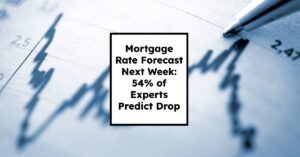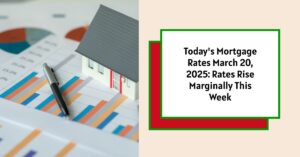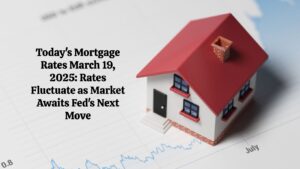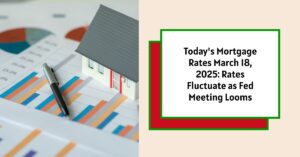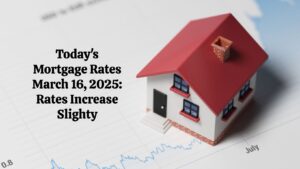Are you glued to your screen, constantly refreshing mortgage rate websites, hoping for a glimmer of good news? If you're in the market to buy a home, or even thinking about refinancing, I get it. The question on everyone's mind is: where are mortgage rates headed? Well, for the week of March 20 – 26, 2025, it seems like there might be a silver lining for those hoping to secure a better deal. Experts are leaning towards mortgage rates going down, but it's not a slam dunk. Let’s dive into what’s driving these predictions and what it could mean for you.
Mortgage Rate Forecast Next Week: 54% of Experts Predict Drop
The Fed's Whisper: Uncertainty is the Word
You know, the world of finance can feel like a giant guessing game sometimes. But when it comes to mortgage rates, it's less about magic and more about following the clues. And right now, a big clue has come straight from the Federal Reserve, or the Fed as everyone calls them. They've basically said, “Hey, things are a bit uncertain right now with the economy.”
This might sound a bit gloomy, but in the weird world of finance, uncertainty can actually be a good thing for mortgage rates in the short term. Think of it like this: when the Fed hints at economic wobbles, it often makes investors a bit nervous about riskier investments, like stocks. So, they tend to flock to safer bets, like government bonds. When bond demand goes up, their yields (which are kind of like bond interest rates) tend to go down. And guess what? Mortgage rates often follow the lead of these bond yields!
That's precisely why a solid 54% of experts polled by Bankrate are predicting mortgage rates will decrease for the week of March 20-26, 2025. They're reading the tea leaves of the Fed's announcement and seeing signs that rates should ease a bit.
Voices Saying “Rates Down”: Why the Optimism?
Let's hear from some of these experts who are in the “rates down” camp. Michael Becker, a Branch Manager at Sierra Pacific Mortgage, hit the nail on the head when he pointed out that the Fed's key phrase was “Uncertainty around the economic outlook has increased.” He believes this is “helping bonds rally and should help mortgage rates improve or move lower in the coming week.”
Heather Devoto from First Home Mortgage echoed this, anticipating “rates to decline in the week ahead, following reaction to the most recent FOMC meeting.” It's all about that Fed meeting and the signals it sent to the market.
Richard Martin, Director of Home Lending at Curinos, also thinks rates will dip. He believes the Fed is indicating that the “economy is softening,” making it “more likely that rate cuts will happen sooner than previously expected.” This is a big deal because rate cuts (even the expectation of them) are generally good news for mortgage rates.
Even Greg McBride, Bankrate's own Chief Financial Analyst, chimes in, saying the Fed expects “weaker economic growth and now bond investors will too.” He believes that “in lieu of hard economic data, bond yields and mortgage rates should move lower in response.” Basically, without strong economic news pushing rates up, the path of least resistance seems to be downwards.
And then there's Les Parker, Managing Director at Transformational Mortgage Solutions, who brings a bit of creative flair to his prediction. He uses a Taylor Swift parody to explain how a move from stocks to safer Treasury bonds can cause mortgage rates to “dip.” It's a fun way to illustrate a serious financial concept!
Nicole Rueth from Movement Mortgage highlights that while inflation is still a concern (“sticky inflation”), the Fed has also lowered its expectations for economic growth (GDP). She points to the “slowing of the pace of Treasury tightening” as having a “longer impact on lowering mortgage rates.” It’s not just about immediate rate cuts, but a shift in the overall approach.
Finally, Sean P. Salter, a finance professor, sums it up by saying that Fed Chairman Powell's comments suggest the central bank is expecting “slower growth and higher-than-target inflation rates.” With bond yields dropping after the Fed's announcement, he expects “mortgage rates to follow.”
Hold Your Horses: “Rates Stay the Same” Isn't Off the Table
Okay, so a majority is leaning towards lower rates. But what about the 31% of experts who think rates will just stay put? Well, they have some valid points too.
Derek Egeberg from MortgageOne believes that as markets “start digesting economic news, government spending and cuts, along with tariff talks,” we should “look for the mortgage and bond market to remain relatively flat.” He emphasizes that the market is waiting for clearer direction from these factors.
Dr. Anthony O. Kellum, CEO of Kellum Mortgage, echoes this sentiment, stating that “with the upcoming Fed meeting, the market will likely hold steady as investors wait for any signals on future policy adjustments.” He thinks that “unless there’s an unexpected shift in economic data or Fed rhetoric,” rates will likely see “minimal movement.”
Dick Lepre from Realfinity points out that the Fed's current policy of keeping rates higher is aimed at “containing inflation.” He also mentions concerns about “Trump tariffs and threats thereof” being inflationary, which could keep rates from dropping significantly. He predicts rates will be “nervously flat.”
Robert J. Smith, Chief Economist at GetWYZ Mortgage, sums it up by saying rates “should continue to be rangebound and relatively flat week over week, provided that there are no surprises coming out of the Fed meeting today.” Essentially, if nothing dramatically changes, expect more of the same.
“Rates Go Up”? The Minority View
And then we have the 15% who think rates might actually tick upwards. Why would they think that when the majority is predicting a drop?
Ken Johnson from the University of Mississippi notes that “in the last two weeks, there has been very little movement in the yield on 10-year Treasurys.” He observes that recent movements have been “more up than down,” leading him to “follow the trend” and predict that “30-year mortgage rates should be higher” next week. Sometimes, it's just about the immediate momentum in the market.
Joel Naroff, President of Naroff Economic Advisors, simply states “Up. The economy is not going away, at least not right away, and neither are tariffs.” He's taking a more direct view – the economy is still kicking, and inflationary pressures like tariffs are still present, which could push rates higher.
Recommended Read:
Mortgage Rates Stay Below 7% for Nine Consecutive Weeks in 2025
Mortgage Rates Drop: Can You Finally Afford a $400,000 Home?
Expect High Mortgage Rates Until 2026: Fannie Mae's 2-Year Forecast
My Take: Cautious Optimism with a Side of Reality
If you ask me, sitting here watching all these predictions unfold, I'm leaning towards the majority view – a slight dip in mortgage rates is likely for the week of March 20-26, 2025. The Fed's signal of economic uncertainty is a pretty strong indicator. However, I also think the “rates stay the same” camp has a point. The economic picture is still complex. Inflation is still a concern, and global events can throw curveballs at any moment.
Here's what I believe is most important: Don't expect a dramatic plunge in rates. We're likely talking about a modest decrease. And even if rates do dip slightly next week, the overall trend for the year is still uncertain. Rates are influenced by so many moving pieces – inflation data, economic growth, Fed policy, and global events.
What should you do? If you're thinking about buying or refinancing, it's always a good idea to keep a close eye on rates and be ready to act if you see a favorable move. Talk to a mortgage professional to get personalized advice based on your situation. And remember, the predictions are just expert guesses based on the information available right now. The mortgage market can be unpredictable, so stay informed and be prepared to adapt.
In short, for the week of March 20-26, 2025, there's a decent chance we'll see mortgage rates edge a bit lower. It's not a guarantee, but it's a reason for cautious optimism in a market that's been tough on homebuyers for a while. Keep watching, stay informed, and good luck out there!
Also Read:
- Will Mortgage Rates Go Down in 2025: Morgan Stanley's Forecast
- Mortgage Rate Predictions 2025 from 4 Leading Housing Experts
- Mortgage Rates Forecast for the Next 3 Years: 2025 to 2027
- 30-Year Mortgage Rate Forecast for the Next 5 Years
- 15-Year Mortgage Rate Forecast for the Next 5 Years
- Why Are Mortgage Rates Going Up in 2025: Will Rates Drop?
- Why Are Mortgage Rates So High and Predictions for 2025
- Will Mortgage Rates Ever Be 3% Again in the Future?
- Mortgage Rates Predictions for Next 2 Years
- Mortgage Rate Predictions for Next 5 Years
- Mortgage Rate Predictions: Why 2% and 3% Rates are Out of Reach
- How Lower Mortgage Rates Can Save You Thousands?
- How to Get a Low Mortgage Interest Rate?
- Will Mortgage Rates Ever Be 4% Again?
